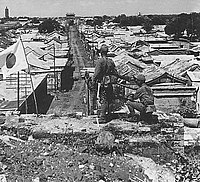The Tungchow Mutiny (通州事件 Tsushu jiken, Chinese: 通州事件; pinyin: Tōngzhōu Shìjiàn), sometimes referred to as the Tōngzhōu Incident, was an assault on Japanese troops and civilians by Chinese troops in Tōngzhōu, China on 29 July 1937 shortly after the Marco Polo Bridge Incident that marked the official beginning of the Second Sino-Japanese War.
In early 1937, Tōngzhōu was capital of the East Hopei Government, a Japanese puppet state controlling the strategic eastern district of Beijing. In July, a detachment of approximately 800 troops of the Chinese 29th Army under command of General Sung Che-yuan and loyal to the Kuomintang government, camped outside the walls of Tōngzhōu, and refused to leave despite the strong protests of the Japanese garrison commander.[1] Unknown to the Japanese, General Sung had reached an agreement with East Hopei leader Yin Ju-keng, who hoped to use the Kuomintang troops to rid himself of the Japanese presence.
On 27 July, the Japanese commander demanded that the Kuomintang soldiers disarm. When they refused, fighting erupted on 28 July, and the outnumbered and outgunned Chinese troops were trapped between the Japanese and the city wall. After some 500 Kuomintang troops were killed, some 5000 troops of the Japanese-trained 1st Corps and 2nd Corps of the East Hopei Army then rose in mutiny, and turned against the Japanese garrison.[1] In addition to Japanese military personnel, some 250 civilian residents of Tōngzhōu (including ethnic Korean-Japanese) were killed in the uprising. According to Japanese sources, the majority of women were raped and some were killed in brutal fashions. Some 60 Japanese civilians survived, but much of the city was destroyed in the fighting.
The massacre shocked public sentiment in Japan, and was used to justify further military intervention under the guise of protecting Japanese property and lives in Beijing by the Japanese government.
Mention of the Tungchow Mutiny appears very rarely in Chinese sources, as Chinese historians believe that the right-wing organizations in Japan use this incident to downplay the atrocities committed by the Imperial Japanese Army in the Nanjing Massacre upon Chinese citizens.
[edit] See also
[edit] References
- Hsu Long-hsuen and Chang Ming-kai, History of The Sino-Japanese War (1937-1945) 2nd Ed. ,1971. Translated by Wen Ha-hsiung , Chung Wu Publishing; 33, 140th Lane, Tung-hwa Street, Taipei, Taiwan Republic of China. Pg.177-180, Map 2
- Jowett, Philip (2005). Rays of the Rising Sun, Volume 1: Japan's Asian Allies 1931-45, China and Manchukuo. Helion and Company Ltd.. ISBN 1874622213.
[edit] Notes
- ^ a b Jowett, Rays of the Rising Sun, Volume 1: Japan's Asian Allies 1931-45, China and Manchukuo, page 48



No comments:
Post a Comment